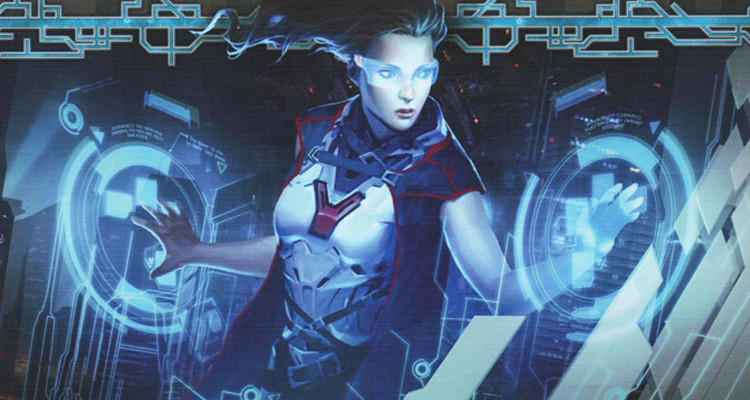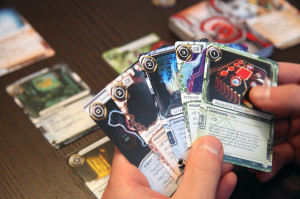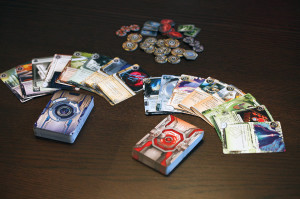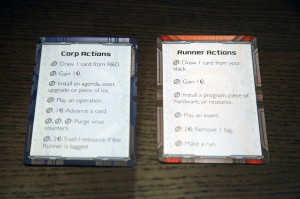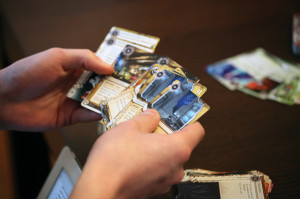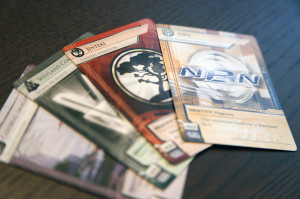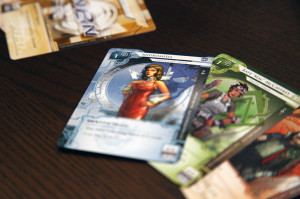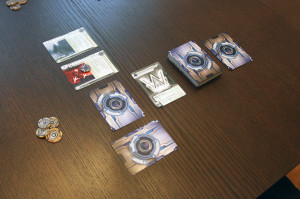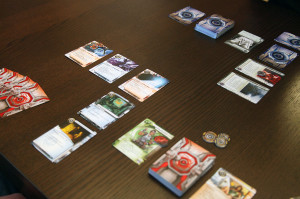INTRODUCTION
In the not-so-distant future, society has begun to crumble under the weight of powerful Mega-Corporations. These entities each exploit their influence and resources for a variety of reasons – respect, for some; wealth for others; even for “the greater good” (though that may be a bit deluded). Above all else, these faceless enterprises seek to control those around them in an effort to reach their personal goals.
For those of you who shudder at the thought – fear not! – amongst the dystopian slums lurk your heroes and heroines: the Runners. These are the tech-savvy hackers (Yes, think “Matthew Lillard,” mesh-top and all) who use whatever and whomever they can to infiltrate, expose and destroy the evil, oppressive Corps (“oppressive” is such a subjective term…).
Android: Netrunner is a representation of this struggle between David and Goliath. The Runner will attempt to disrupt the Corporation’s plans and topple the giant, while “The Man” will see to advancing their agenda and maintaining control.
DESIGN
Originally designed by Richard Garfield (We’re not worthy!), Netrunner was a collectible card game published by Wizards of the Coast in the mid-90’s. It met with moderate success, gained a loyal following, and ultimately fell off the map and was discontinued. In 2012, Android: Netrunner was released as an addition to Fantasy Flight Games’ Living Card Game (LCG) line (joining Call of Cthulu, Warhammer: Invasion, The Lord of the Rings and A Game of Thrones). A:NR is largely based on Garfield’s original game, but with a large cosmetic and design overhaul, courtesy of Lucas Litzsinger and his team at FFG.
A:NR is an asymmetrical card game for two players in which one player assumes the role of a Corporation and the other player becomes a Runner. “But, Buns, what in the world is an asymmetrical card game?” Thank you for asking, [INSERT NAME HERE]. Simply put, the Corp and the Runner play very differently from one another and each has a different win condition. This means that, while the two players will interact frequently throughout the game, each side will have different cards and actions available to them that will lead to a different goal. As hinted at in its thematic description, the Corporation will be working toward advancing and scoring 7 points worth of their agendas, while the Runner will be looking to hack into servers and steal 7 points worth of the Corporation’s agendas. Whichever side can do this first wins.
Being an FFG product, it is safe to say that Netrunner consists of some of the best board/card game components on the market. The Core Set provides 252 cards total and several sheets of punch-out tokens. The cards are Standard-sized (FFG “Gray-Sized”) and are made from high-quality card stock. Similarly, although the tokens are cardboard, they feature thick-layered material and unique artwork for each of their individual purposes. The box and provided insert are both sturdy, but with any amount of expansion (there are currently 10 small-pack expansions and one “deluxe” box-set), you will quickly be searching for a new storage solution.
Before shifting into what exactly happens in this game, a discussion (or disclaimer, maybe) about the graphic design, terminology and rulebook is in order. Android: Netrunner provides one of the most immersive translations of theme into mechanics that I have ever encountered in a game. This is something that is worth appreciating every time this game hits the table; however, this can pose a legitimate barrier to entry. Netrunner has created a fully unique system of terms and symbols to be used on their cards and in their rules. Allow me to demonstrate:
- Click – Taking actions utilizes “clicks.” (e.g. Spend 1 “click” to draw a card)
- Credit – The currency of the Android universe (This one isn’t so off-the-wall)
- Server – The different play areas of the Corporation
- Grip – The Runner player’s hand of cards
- HQ – The Corporation player’s hand of cards
I make this point to emphasize that this game does not utilize common vernacular (see what I did there?) to describe things that you would normally understand. I could say, “You take one Net Damage” or I could say what that actually means: “You have to discard one random card from your hand.” This, coupled with the very unique way in which cards are played in Netrunner, can make the game tough to get into. My advice: Have someone teach you. The thematic elements might be my favorite thing about the game, but they could easily contribute to you tossing the rulebook aside and walking away or adding it to your trade list. That being said, this disclaimer is not true for everyone; someone had to read the rulebook to teach the rest of us, right?
GAMEPLAY
Once you’ve accepted that Netrunner may be a little bit foreign, but that you’re interested enough to give it a shot, you’re ready to jump in. Below I will go into a brief description of how the game is generally played.
Set-Up
To start a game of Netrunner, each player will need a deck. One player will be the Corporation, the other the Runner. Deck compositions will vary, but there are a few general rules:
- Runner cards and Corp cards may only be used in their respective decks. No mixing.
- Corporation decks must include a certain number of Agenda points, based on the number of total cards in the deck (e.g. A 49 card deck must have between 20-21 agenda points)
- Runner and Corp decks must adhere to the Minimum Deck Size and Influence limits provided by their chosen identity card.
There are currently 3 Runner factions and 4 Corporation factions, each with its own general flavor and play-style. A player’s deck will be built around one of these faction “identities,” which provide a unique power and limitations to how your deck can be built. A standard Corp or Runner deck will have a 45-card minimum with 15-points of outside influence allowed. Each card is given an “influence” value. Including cards from outside of your faction uses up this influence. This is most relevant for deck-building. In the Core Set, pre-made decks are provided so that you don’t need to worry about deck-building unless you choose to.
Each player will shuffle their deck and deal a starting hand of five cards. Their identity cards and draw decks will then be set-up within the player area as dictated by their given side.
The Runner player will have:
- Grip – The player’s hand of cards.
- Stack – The player’s draw deck
- Heap – The player’s discard pile.
- Rig – The area where the player will “install” (put into play) ICE Breakers, Hardware and Resources
The Corporation player will have:
- HQ – The player’s hand of cards.
- R&D – The player’s draw deck.
- Archives – The player’s discard pile.
- Remote Servers – The area where Agendas and Assets will be installed.
- ICE Area – The area in front of each server where ICE will be installed.
Game Turn
Once set up, play will begin with the Corporation. At the beginning of each turn, the Corporation conducts a mandatory card draw from the top of his/her R&D. From there, the Corp has 3 clicks worth of actions to take.
The available Corp actions are:
- Spend one click to draw a card from R&D
- Spend one click to gain 1 credit
- Spend one click to install an agenda, asset, upgrade or piece of ICE
- Spend one click to play an operation
- Spend three clicks to purge virus counters
- Spend one click and 2 credits to trash one resource if the Runner is tagged
- Spend one click and one credit to advance a card
“Wait. WHAT?!”
So, listing all of those out may not be the most helpful, but I wanted to at least show the wealth of things that you can do. Now, what do those actions actually mean and do? All of these actions revolve, in some way, around helping the Corp win the game by “advancing agendas.” The reason that I used bold text for Action 7 (above) is because this is how you directly score points and win the game. Each agenda has an advancement limit on it. By spending one click and one credit, the Corp may place an advancement token on an agenda that’s in play (see Action 3). Once the agenda has tokens on it equal to or greater than that advancement limit, it may be scored for its agenda value. Get seven points and you’ve just bested the Runner and succeeded in being a powerful Mega-Corp.
The rest of the available actions are used to gain money, advance agendas faster, install powerful programs to protect your installed cards, and generally give the Runner a hard time for trying to steal your precious hard work.
After three clicks worth of actions, the Corp discards down to their maximum hand size (usually 5) and the turn passes to the Runner. One the Runner’s turn, there is no mandatory draw. Instead, the Runner has four clicks that can be spent on these actions:
- Spend one click to draw a card from the top of your stack
- Spend one click to gain one credit
- Spend one click to install a program, peice of hardware, or a resource
- Spend one click to play an event
- Spend one click and 2 credits to remove a tag
- Spend one click to make a run
I can only assume you have the same questions as before – “what does it all mean!?” Similar to the Corp advancing agendas, I have made the text of the core of the Runner’s actions bold – making “runs.” A run is an attempt to steal the Corporation’s agendas. When initiating a run, the Runner has the choice of attacking either the Corp’s Archives, R&D, HQ or a card installed in a remote server. This means that the Runner can go through your discard, deck and hand, in addition to anything you play on the table, in his/her hunt for points. If they happen upon one of the Corp’s secret agendas, they steal it and score points equal to its agenda value (same as the Corp would if advanced successfully). Similar to the Corp, the rest of the available actions are there to support the Runner in making successful runs and finding those agendas. Their cards help gain money, get through the Corporation’s defenses and generally make life hard for those in charge. Steal 7 points before the Corp advances 7 and you’ve foiled their plans, exposing them for the corrupt Capitalists that they are.
If the game sounds straightforward enough, that’s because it is.
Except for the fact that the Corporation plays all of his/her cards face-down.
As a Runner, outside of events (cards with a one-time effect), your cards generally need to be in the play-field before they can be used. This means that the Corp often knows the tools you have and how close you are to being able to steal the goods. The Corp, on the other hand, is Almighty. Their ICE (server defenses), agendas and assets (cards with recurring effects) will all be hidden. Now, face-down cards have no effect until they are turned face up (this is called “rezzing”) by paying the card’s cost – but that means that there can be hidden cards all over the place just waiting to strike. Is that face-down card you’re running a trap that will hurt you or the agenda you need to win the game? This. This is the heart of Netrunner.
As stated in the beginning, this is a vastly insufficient description of how to actually play Android: Netrunner, but it does give you a little taste for what is going on during the game. I direct you, once again, to the excellent resources available elsewhere on the web for a detailed explanation on how to play. In their short video, FFG manages to capture and explain the game quite well.
OVERALL EXPERIENCE
I have talked at length about bits and pieces of Netrunner, but I want to use this section to consolidate my commentary into more of an analysis and less of an explanation.
Android: Netrunner is a relatively deep and layered game that is made infinitely more complex by introducing the human element. It utilizes the micro-interactions and bluffing elements found in a game like Poker and combines them with a unique card game system that is all its own (outside of the original, of course). Mastery consists of equal parts understanding of the card pool and understanding of your opponent – but both are in the context of an ever-changing board state. Imagine a game of chess where you couldn’t see your opponents pieces until you were right on top of them. Success in Netrunner requires delicacy amidst chaos; precision and unpredictability. All of this is to say that the balance between Corp and Runner is as important as the balance within your own playstyle. It is an extremely engrossing experience.
In my opinion, there are three components that provide this experience:
- Asymmetry.The one-sided nature of the game is dependent and influenced upon the other side. Each action is your own, but it directly impacts both your next action and the future actions of your opponent as you work to achieve separate goals.
- Hidden Information. This aspect of the game makes two solitaire games one cohesive piece. Not knowing what cards are on the Corp’s play area makes Netrunner as much about playing the opponent as it is about the play field. The odds ratios and probabilities will only get you so far because a single deck, in the hands of different players, can be played entirely differently. Now, there are still optimal plays and popular decks – but if I know you’re expecting me to make that “optimal play,” is the actual best play to do something different?
- Factions and Influence. Less touched upon above, I feel that this is the backbone of the game’s success. The factions and influence system were designed for this re-imagining of the original game and they provide the structure that the 90’s version is said to lack. What this system provides, for casual and competitive players alike, is a little more predictability and a new surprise factor, simultaneously. When I sit down at the table and you put out your faction identity, I am immediately able to narrow 80% of your deck to a very limited card pool (all of those that are in-faction). At the same time, the outside influence you are provided means that the entire rest of the card pool is available and I have no idea what you chose to include. The only way to find out is to play and, when you throw down that card I wasn’t expecting (You spent 5 influence on a Wotan in NBN!?), now I have the challenge of reacting to it.
That being said, no game is perfect. Android: Netrunner is no different. I spoke about barriers to entry earlier and will mention them again. This game may not be for everyone for a variety of reasons including that (1) it’s a card game, (2) it’s cyber-punk themed, (3) it’s system is very different from other games people may have played and (4) it can honestly be a bit confusing at times. The first time I picked up the rulebook, I quickly set it down and walked away from it for several months. I eventually used some internet tutorials and got it to the table with my girlfriend.
As a casual game, Netrunner provides a great pick-up-and-play experience that can be played quickly with pre-made decks. Our first games ran a bit long at an hour+ (not typical), but quickly settled in around the 45 minute range (Once I started playing competitively, game time was easily around 30 minutes). Not much of a deck builder? The Core set and Deluxe expansions each provide pre-constructed deck lists that can be played out of the box. Every pack has the same cards, so $40 or less can get you a Core set with all that is needed to play.
For those looking for more, monthly data packs (with all the same cards) are available at $15 or less and provide a wider range of card selection. These are also a must for the competitive scene, as the small card pool is often heavily influenced every few data packs. For those interested in leagues and tournaments, ANR has an ever-growing following that is actively supported by the team at FFG. Of particular note was the National Championships at GenCon this past August, which capped at 240 registered players and had roughly 185 of those in attendance. My experience with the community has been overwhelmingly positive and filled with people who just have a fondness for this game and want it to thrive. The Board Game Geek page (here) is constantly buzzing with new information and discussion surrounding the game.
Given the relatively low price point, compared to the surrounding board game market, Android: Netrunner is worth giving a shot if the theme and general idea of the gameplay interests you. It can be taken for what it is out of the box and simply played as a two-player board game, or it can be expanded as you see fit. The game is still young and it is difficult to say where it will lead, but the current trend is up. For additional opinions, please review the various league rulings below and utilize the community resources available for the game.
LEAGUE RULING
Buns
Underneath the layer of cyber-punk jargon is a deeply tactical and thought-provoking game that can be scaled and customized to completely fit your playstyle. Whether a casual player, card-collector, or focused competitor, A:NR can fit your needs. Initially starting out, I played this game solely with my girlfriend who rarely dabbles into heavier games and doesn’t bother with competitive card-games. Netrunner grabbed us both, though. The basic mechanics were easy enough to understand that we were able to able to sit down at the table for an hour, with some thrown-together decks, and have a great time. As I fell deeper into deck-building, I was able to branch out to a local game-group (the Baltimore Meta – those dudes are the real deal) and have a go at the tournament scene. I even got tossed around the National Championships at GenCon 2013 with a smile on my face the whole time. Every game has provided a new challenge – a new puzzle where some of the pieces are hidden in my opponent’s head and hand. Beyond the gameplay, I am completely enamored with the style, theme and flavor of A:NR. There is so much personality in each of the factions that you find yourself gravitating to particular characters and playstyles. Using the clever deckbuilding mechanics, you may find yourself trying to fit a new strategy into your favorite faction, just because you like them the best (How can I fit this Jinteki shaped peg in this Haas-Bioroid shaped hole…). Similarly, as I’ve collected the cards, I often find myself chuckling at witty flavor-text or examining the art for Easter eggs. While I could speak at length about my love for this game, I will simply say that A:NR provides a truly unique gaming experience. I recognize that this game will not be for everyone, but those who are peaked by the theme or the gameplay will find a lot here.
Smee’s Two Pence
Netrunner is one of the games that I’ve long enjoyed, from the initial cult following of WoTC’s offering, through its decline, and now resurgence. While the Android franchise is not my favorite setting, I feel that FFG has made an admirable effort to adapt the best parts of the old set and update it to settle in with the new background. Losing a few of the more cumbersome, yet unique mechanics, this version of Netrunner trades a modicrum of charm in order to offer a sleeker, faster interface and experience. While the LCG packaging is much more wallet-friendly than the prior TCG incarnation, the constantly-shifting card pool may throw off those that choose to only dabble. All in all, I offer four and a half stars, along with two thumbs up for this series.

